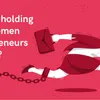
Former U.S. Secretary of State Hillary Clinton once said, “Women are the largest untapped reservoir of talent in the world.” And this statement couldn’t be more true. Even in developing countries like India, the percentage of women entrepreneurs is still a mere 23.3%. It sure is a long road of journey for women who want to go to great heights in the business world.
However, the success story of a woman entrepreneur also comes with amazing rewards. So if you are a woman entrepreneur or you are a woman who wants to enter the world of entrepreneurship, you need to familiarise yourself with terms that can help you on your journey toward success.
1. Glass Ceiling
Every woman in her life goes through some obstacles on the road to achieving her dream. Such “obstacles” or “invisible barriers” that restrict women’s advancement and upward mobility in the business world are called glass ceilings.
This metaphor means that although it seems like businesswomen are more accepted and seem equal to their male counterparts corporate world, there are several barriers, including gender biases, societal expectations, lack of access to resources for women entrepreneurs and networks, and discriminatory practices within organisations.
2. Gender pay gap
According to the World Economic Forum’s Global Gender Gap Report 2023, the global gender pay gap stands at 23%, meaning that women earn, on average, 77 cents for every dollar earned by men. The gender pay gap means that there are differences in the earnings between men and women in the workforce. It is a common scene in the business world that women are paid less than men for the same work.
Addressing the gender pay gap requires a multi-faceted approach. It involves promoting equal opportunities for women in education and training, challenging gender stereotypes, implementing fair and transparent pay practices, and fostering supportive workplace cultures.
3. Gender Bias
Gender bias is the act of treating men and women differently. In the business world, women sometimes are considered inferior to men and treated poorly. Statistics show that 35% of women entrepreneurs have experienced gender bias like gender stereotypes, glass ceilings, gender pay gaps, unconscious attitudes, etc., on a day-to-day basis.
Eradicating gender bias requires creating strong awareness and educating both men and women about individual rights. When there is no gender bias, there will be equal opportunity for everyone in the field to showcase their innate abilities.
4. Mentorship for women
Mentorship is like a training workshop where women are guided to navigate the corporate world. During the mentorship programme, a more experienced person, known as a mentor, provides advice, knowledge, and encouragement to a woman seeking guidance in her personal or professional development.
The mentor can be an individual who shares their struggles, tips, and tricks with the mentee. Mentorship for women is particularly important because it addresses specific challenges and biases that women may face in various fields or industries. Mentorship can also help women to get angel investors, crowdfunding for women entrepreneurs, equity financing, and resources for women entrepreneurs.
.thumbnailWrapper
width:6.62rem !important;
.alsoReadTitleImage
min-width: 81px !important;
min-height: 81px !important;
.alsoReadMainTitleText
font-size: 14px !important;
line-height: 20px !important;
.alsoReadHeadText
font-size: 24px !important;
line-height: 20px !important;

5. Diversity and inclusion
Diversity and inclusion are two interconnected concepts that promote equal opportunities and create environments where all individuals feel valued and respected. Diversity refers to the range of individual differences and unique characteristics that people bring to a particular setting. These differences can include factors such as race, ethnicity, gender, age, sexual orientation, religion, disability, socioeconomic status, and more.
Inclusion refers to including all these different types of people and creating various policies, especially women entrepreneur schemes to grow. Inclusive practices ensure that everyone feels a sense of belonging, is treated fairly, and has equal access to opportunities, resources, and decision-making processes.
6. Women-focused accelerators
Women-focused accelerators are programmes or initiatives designed specifically to support and empower women entrepreneurs in their business ventures. These accelerators provide a supportive ecosystem that addresses the unique challenges and barriers faced by women in entrepreneurship.
They create a safe environment where women can share their struggles and find solutions for them. Women-focused accelerators also help other women entrepreneurs in various ways like helping them in raising capital, providing mentorship opportunities to build confidence, gain valuable insights, and navigate the complexities of running a business.
Indian Angel Network’s Women Entrepreneurship Platform, Beyond 8, and Women’s Startup Lab are some of the famous Women-focused accelerators in India.
7. Women-centric marketing
The strategic and marketing techniques used by companies to target and cover businesswomen are known as women-centric marketing. Developing marketing campaigns, products, and services that cater to the needs, preferences, and values of women are some of the strategies followed by these companies.
Women-centric marketing often emphasises inclusivity, empowerment, and representation. It recognises women as decision-makers and seeks to empower them by addressing their concerns, promoting their aspirations, and showcasing their achievements. This marketing technique builds a good rapport with the women audience by showcasing an understanding of their perspectives and priorities.
8. Gender-responsive financing
As the world progresses in terms of knowledge and breaking barriers, the traditional financial system may not adequately address the specific challenges that women and other marginalised genders encounter. Gender-responsive financing is an approach to providing financial services and support that takes into account the unique needs, constraints, and opportunities faced by different genders.
Gender-responsive financing provides various schemes for women entrepreneurs in India financially that focus on inclusion and empower individuals of all genders to access and benefit from financial services. It involves designing and implementing financial products, services, and policies that address the gender-based disparities in access to finance, investment opportunities, and economic resources.
9. Gender mainstreaming
The decision to ensure every gender is heard equally is called gender mainstreaming. It helps to remove gender inequalities and discrimination by promoting equal opportunities and rights for everyone.
Gender mainstreaming encourages the active participation and representation of women and gender-diverse individuals in decision-making processes. It aims to create inclusive spaces where diverse voices are heard and where women and gender-diverse individuals have equal opportunities to contribute to and influence policy and programme development.
.thumbnailWrapper
width:6.62rem !important;
.alsoReadTitleImage
min-width: 81px !important;
min-height: 81px !important;
.alsoReadMainTitleText
font-size: 14px !important;
line-height: 20px !important;
.alsoReadHeadText
font-size: 24px !important;
line-height: 20px !important;

10. Women in STEM
STEM stands for Science, Technology, Engineering, and Mathematics. Women In STEM are academic achievers in these fields. When we have more women in these fields, we bring different perspectives, ideas, and approaches to the table. It leads to more creativity, innovation, and problem-solving.
Some notable names include:
- Marie Curie, A physicist, and chemist and the first woman to win a Nobel Prize
- Ada Lovelace – The world’s first computer programmer
- Grace Hopper – Computer scientist and U.S. Navy rear admiral
- Kalpana Chawla – Astronaut and the first Indian woman in space
- Tessy Thomas – Scientist popularly known as the “Missile Woman of India”
These are a few of the many examples of women in STEM.
11. Gender-conscious leadership
The leadership style that is mindful of the different experiences, perspectives, and challenges faced by individuals of different genders and taking proactive steps to create an inclusive and equitable environment is called gender-conscious leadership. Gender-conscious leaders understand the underlying gender disparities and promote gender equality within an organisation or community.
Maintaining a gender-conscious leadership means having an awareness of the gender bias that people face. It also means creating an inclusive environment where everyone feels heard. A few ways through which these are put into practice are by having pay equity, flexible work arrangements, parental leave policies, and initiatives to address the underrepresentation of women and other marginalised genders in leadership positions.
12. Gender lens investing
A fancy term that refers to the act of taking into account gender equality and women empowerment while investing is called gender lens investing. Investors choosing to back companies using gender lens typically look at that have strict policies that promote gender equality, support women’s empowerment, and tackle issues like gender-based violence, workplace diversity, equal pay, and women’s leadership.
Basically, gender lens investing recognises that women often face unique challenges and inequalities in various aspects of life, including access to education, healthcare, financial services, and employment opportunities. Gender lens investors understand these hurdles and invest in businesses and initiatives that promote women’s welfare to bring positive change in society.
Knowing these terms will help you as a woman entrepreneur to understand and navigate situations better. Remember: Becoming a businesswoman is not a destination but it is a lifelong journey. We wish you good luck on your entrepreneurial journey!
If you wish to follow the inspirational stories of other women entrepreneurs in India, check out HerStory, our exclusive coverage of inspirational women in the business world.









![Read more about the article [Startup Bharat] This agritech company boosts crop yields with protective farming inputs](https://blog.digitalsevaa.com/wp-content/uploads/2022/04/GrowitSB-1651136907739-300x150.png)
